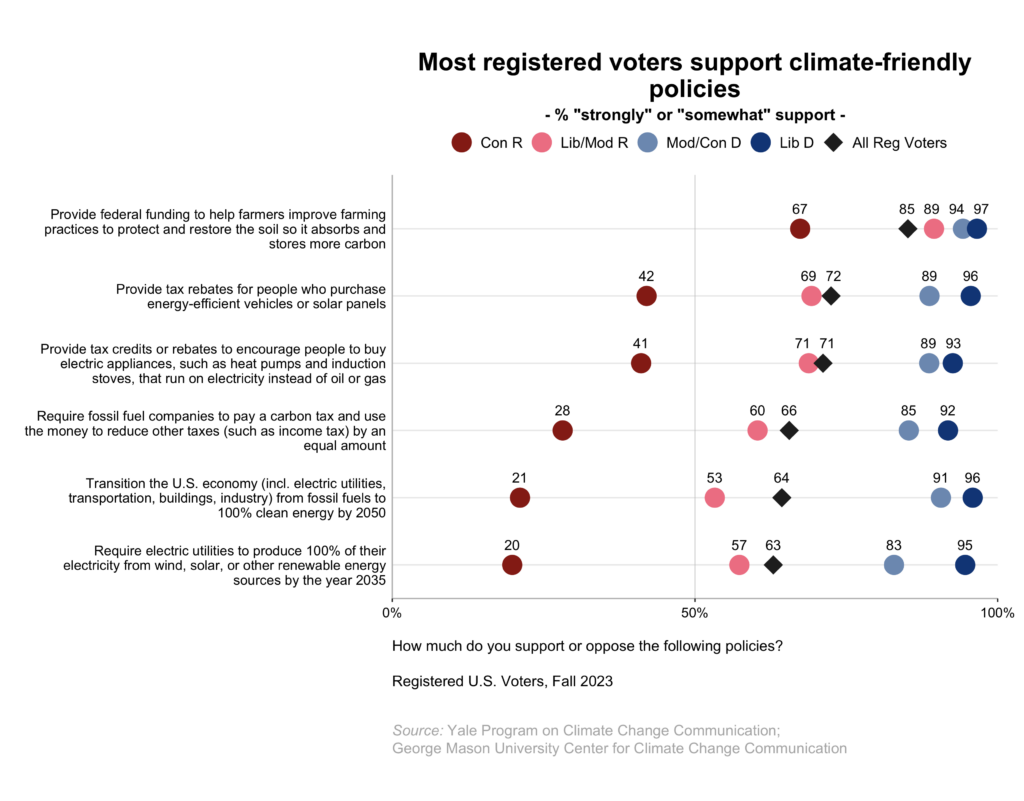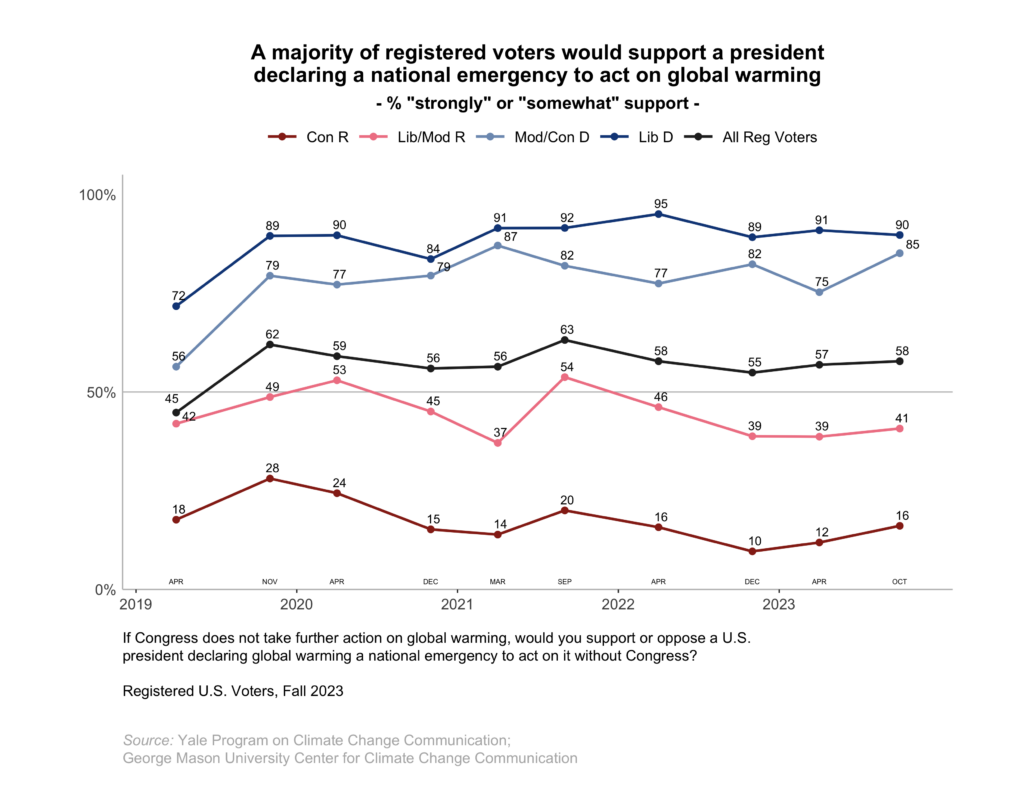Report · Nov 29, 2023
Climate Change in the American Mind: Politics & Policy, Fall 2023
By Anthony Leiserowitz, Edward Maibach, Seth Rosenthal, John Kotcher, Emily Goddard, Jennifer Carman, Marija Verner, Matthew Ballew, Jennifer Marlon, Sanguk Lee, Teresa Myers, Matthew Goldberg, Nicholas Badullovich and Kathryn Thier
Filed under: Policy & Politics
3. Support for Policies to Reduce the Pollution that Causes Global Warming
3.1. Most registered voters support climate-friendly policies.
Registered voters across the political spectrum support many energy policies designed to reduce carbon pollution and fossil fuel dependence and promote clean energy, including:
- Providing federal funding to help farmers improve practices to protect and restore the soil so it absorbs and stores more carbon: 85% of registered voters, including 97% of liberal Democrats, 94% of moderate/conservative Democrats, 89% of liberal/moderate Republicans, and 67% of conservative Republicans.
- Providing tax rebates to people who purchase energy-efficient vehicles or solar panels: 72% of registered voters, including 96% of liberal Democrats, 89% of moderate/conservative Democrats, 69% of liberal/moderate Republicans, and 42% of conservative Republicans.
- Providing tax credits or rebates to encourage people to buy electric appliances, such as heat pumps and induction stoves, that run on electricity instead of oil or gas: 71% of registered voters, including 93% of liberal Democrats, 89% of moderate/conservative Democrats, 71% of liberal/moderate Republicans, and 41% of conservative Republicans.
- Requiring fossil fuel companies to pay a carbon tax and using the money to reduce other taxes (such as income tax) by an equal amount [i.e., a revenue-neutral carbon tax]: 66% of registered voters, including 92% of liberal Democrats, 85% of moderate/conservative Democrats, 60% of liberal/moderate Republicans, and 28% of conservative Republicans.
- Transitioning the U.S. economy (including electric utilities, transportation, buildings, and industry) from fossil fuels to 100% clean energy by 2050: 64% of registered voters, including 96% of liberal Democrats, 91% of moderate/conservative Democrats, 53% of liberal/moderate Republicans, and 21% of conservative Republicans.
- Requiring electric utilities to produce 100% of their electricity from renewable energy sources by 2035: 63% of registered voters, including 95% of liberal Democrats, 83% of moderate/conservative Democrats, 57% of liberal/moderate Republicans, and 20% of conservative Republicans.
3.2. A large majority of registered voters support renewable energy generation on public land.
A large majority of registered voters (78%) support generating renewable energy (solar and wind) on public land in the United States. This includes nearly all liberal Democrats (94%) and moderate/conservative Democrats (91%) as well as a large majority of liberal/moderate Republicans (79%) and about half of conservative Republicans (55%).
Fewer registered voters support fossil-fuel production in the United States, including:
- Expanding offshore drilling for oil and natural gas off the U.S. coast: 52% of registered voters; 81% of conservative Republicans, 76% of liberal/moderate Republicans, 39% of moderate/conservative Democrats, and 26% of liberal Democrats.
- Drilling for and mining fossil fuels (coal, oil, and natural gas) on public land in the U.S.: 49% of registered voters; 80% of conservative Republicans, 73% of liberal/moderate Republicans, 33% of moderate/conservative Democrats, and 20% of liberal Democrats.
3.3. A majority of registered voters support building clean energy infrastructure in their local area.
Majorities of registered voters support climate-friendly energy production and distribution infrastructure in their local area, including solar farms (61%), wind farms (55%), electric vehicle charging stations (52%), and high-voltage power lines to distribute clean energy (52%). This generally includes majorities of liberal Democrats and moderate/conservative Democrats, and many liberal/moderate Republicans, but fewer conservative Republicans:
- Solar farms: liberal Democrats, 81%; moderate/conservative Democrats, 74%; liberal/moderate Republicans, 54%; conservative Republicans, 37%.
- Wind farms: liberal Democrats, 76%; moderate/conservative Democrats, 69%; liberal/moderate Republicans, 50%; conservative Republicans, 30%.
- Electric vehicle charging stations: liberal Democrats, 83%; moderate/conservative Democrats, 65%; liberal/moderate Republicans, 36%; conservative Republicans, 25%.
- High-voltage power lines to distribute clean energy: liberal Democrats, 66%; moderate/conservative Democrats, 60%; liberal/moderate Republicans, 41%; conservative Republicans, 42%.
Fewer registered voters support building nuclear power plants in their local area (31%), including 43% of conservative Republicans, 29% of liberal Democrats, 28% of moderate/conservative Democrats, and 20% of liberal/moderate Republicans.
3.4. A majority of registered voters would support a president declaring a national emergency to act on global warming.
More than half of registered voters (58%) would either “strongly” (26%) or “somewhat” (32%) support a U.S. president declaring global warming a national emergency to act on it if Congress does not take further action (refer to data tables, p. 48). This would be supported by large majorities of liberal Democrats (90%, with 56% saying they “strongly support” it) and moderate/conservative Democrats (85%; 36% strongly support). By contrast, 41% of liberal/moderate Republicans and 16% of conservative Republicans would support it, while 59% of liberal/moderate Republicans and 84% of conservative Republicans would oppose it (including 66% who would “strongly oppose” it).



